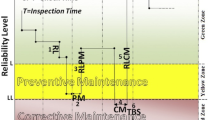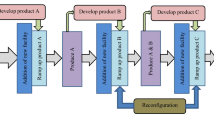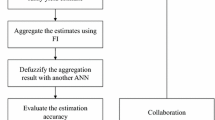Abstract
Reducing cycle time is an essential task that enables dynamic random access memory (DRAM) manufactures to maintain sustainability and gain competitiveness. However, the uncertainty of cycle times makes this a challenging task. Overestimating or underestimating cycle times leads to an incorrect assessment of the effects of an action performed to reduce the cycle time. To address this problem, in this study, the uncertainty of the cycle time was considered and modeled using a fuzzy value. A fuzzy back-propagation network (FBPN) approach is proposed to estimate the cycle time of a job based on its attributes and factory conditions. The lower and upper bounds of the cycle time established using the FBPN approach are tight. In addition, an FBPN can be applied to assess the effects of a cycle time reduction action that shortens the cycle time of a job by improving control over factory conditions. The control action is flexible because the attitude of the managers is considered. Furthermore, a control mechanism for multiple consecutive jobs is established. To illustrate the applicability of the proposed methodology, a DRAM factory simulator was used to generate data. According to the experimental results, the ranges of cycle times, including the ±3σ range, determined using the FBPN approach were narrower than those determined using four existing methods. In addition, the relationship between the cycle time and attributes of a job was determined to be different when the upper (or lower) bound of the cycle time rather than the most likely value was considered.












Similar content being viewed by others
Notes
Demand rate. The cycle time should be at least as short as the takt time to ensure that production can match demand.
References
Browning TR (1998) Use of dependency structure matrices for product development cycle time reduction. In: Proceedings of fifth ISPE international conference on concurrent engineering: research and applications, Tokyo, Japan
Burgelman RA, Grove AS (1996) Strategic dissonance. Calif Manag Rev 38(2):8–28
Chang P-C, Hsieh J-C, Liao TW (2001) A case-based reasoning approach for due date assignment in a wafer fabrication factory. In: Proceedings of the international conference on case-based reasoning, Vancouver, BC, Canada
Chen T (2010) An optimized tailored nonlinear fluctuation smoothing rule for scheduling a semiconductor manufacturing factory. Comput Ind Eng 58:317–325
Chen T (2003) A fuzzy back propagation network for output time prediction in a wafer fab. Appl Soft Comput 2:211–222
Chen T (2013) An effective fuzzy collaborative forecasting approach for predicting the job cycle time in wafer fabrication. Comput Ind Eng 66:834–848
Chen T (2014) Strengthening the competitiveness and sustainability of a semiconductor manufacturer with cloud manufacturing. Sustainability 6:251–268
Chen T, Romanowski R (2013) Precise and accurate job cycle time forecasting in a wafer fabrication factory with a fuzzy data mining approach. Math Prob Eng, Article ID 496816, 1–14
Chen T, Wang YC, Wu HC (2009) A fuzzy-neural approach for remaining cycle time estimation in a semiconductor manufacturing factory—a simulation study. Int J Innov Comput Inf Control 5:2125–2139
Lin E, Minis I, Nau DS, Regli WC (1997) Virtual manufacturing. http://www.isr.umd.edu/Labs/CIM/virtual.html
Liu X-W, Han S-L (2005) Ranking fuzzy numbers with preference weighting function expectations. Comput Math Appl 49(11–12):1731–1753
Lu SCH, Ramaswamy D, Kumar PR (1994) Efficient scheduling policies to reduce mean and variation of cycle time in semiconductor manufacturing plant. IEEE Trans Semicond Manuf 7:374–388
Nazzal D, Mollaghasemi M, Anderson D (2006) A simulation-based evaluation of the cost of cycle time reduction in Agere systems wafer fabrication facility—a case study. Int J Prod Econ 100:300–313
Ng B, Ferrin BG, Pearson JN (1997) The role of purchasing/transportation in cycle time reduction. Int J Oper Prod Manag 17:574–591
Nocedal J, Wright SJ (2006) Numerical optimization. Springer, Berlin
Pearn WL, Chung SL, Lai CM (2007) Due-date assignment for wafer fabrication under demand variate environment. IEEE Trans Semicond Manuf 20(2):165–175
Seth D, Gupta V (2005) Application of value stream mapping for lean operations and cycle time reduction: an Indian case study. Prod Plan Control Manag Oper 16(1):44–59
Shimada Y, Sakurai K (2003) A new accurate yield prediction method for system-LSI embedded memories. IEEE Trans Semicond Manuf 16(3):436–445
Vanguard International Semiconductor Corporation (2014) Corporate overview. http://www.vis.com.tw/visCom/english/a_about/a0101_overview.htm
Wein LM (1998) Scheduling semiconductor wafer fabrication. IEEE Trans Semicond Manuf 1:115–130
wiseGEEK (2014) What are the benefits of virtual manufacturing? http://www.wisegeek.com/what-are-the-benefits-of-virtual-manufacturing.htm
Yi-Tzer E (1995) What virtual manufacturing is. http://www.isr.umd.edu/Labs/CIM/vm/vmdesc.html
Zimmermann HJ (1991) Fuzzy set theory and its applications. Kluwer Academic, Boston
Acknowledgments
This work was supported by National Science Council of Taiwan.
Author information
Authors and Affiliations
Corresponding author
Rights and permissions
About this article
Cite this article
Chen, T. A fuzzy back-propagation network approach for planning actions to shorten the cycle time of a job in dynamic random access memory manufacturing. Neural Comput & Applic 26, 1813–1825 (2015). https://doi.org/10.1007/s00521-015-1854-7
Received:
Accepted:
Published:
Issue Date:
DOI: https://doi.org/10.1007/s00521-015-1854-7




